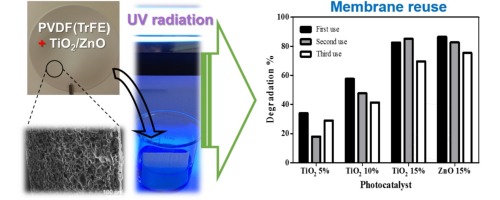Pollutants present in water are increasingly becoming an important public health issue. After their transportation across the sewer network they can pass through the wastewater treatment plants (WWTPs) mostly unchanged because WWTPs are not designed to remove pollutants present at trace levels. Conventional treatments are therefore ineffective. Immobilized photocatalytic systems are thus an advantage for the treatment of contaminated water, because they are ecofriendly, cost-effective and allow reusability. This work reports on TiO2 and ZnO commercial nanoparticles immobilized in poly(vinylidene difluoride)co-trifluoroethylene (P(VDF-TrFE)). Nanocomposites of P(VDF-TrFE) with different concentrations of TiO2 nanoparticles (5, 10, and 15 wt.%) and ZnO nanoparticles (15 wt.%) were produced by solvent casting and tested on the degradation of methylene blue, a model organic dye. Each nanocomposite was tested three times to assess its reusability. It is shown that increasing the photocatalyst concentration results in higher photocatalytic efficiencies; the degradation rates of 15% of TiO2 and ZnO are similar; and the photoactivity decreases 6%, 16%, 13%, and 11% after three utilizations, for TiO2 5%, TiO2 10%, TiO2 15%, and ZnO 15%, respectively. Thus, the low decrease in the photocatalytic activity after three uses makes the nanocomposites suitable for applications in which reusability is an important key factor. (C) 2016 Elsevier B.V. All rights reserved.

Pollutants present in water are increasingly becoming an important public health issue. After their transportation across the sewer network they can pass through the wastewater treatment plants (WWTPs) mostly unchanged because WWTPs are not designed to remove pollutants present at trace levels. Conventional treatments are therefore ineffective. Immobilized photocatalytic systems are thus an advantage for the treatment of contaminated water, because they are ecofriendly, cost-effective and allow reusability. This work reports on TiO2 and ZnO commercial nanoparticles immobilized in poly(vinylidene difluoride)co-trifluoroethylene (P(VDF-TrFE)). Nanocomposites of P(VDF-TrFE) with different concentrations of TiO2 nanoparticles (5, 10, and 15 wt.%) and ZnO nanoparticles (15 wt.%) were produced by solvent casting and tested on the degradation of methylene blue, a model organic dye. Each nanocomposite was tested three times to assess its reusability. It is shown that increasing the photocatalyst concentration results in higher photocatalytic efficiencies; the degradation rates of 15% of TiO2 and ZnO are similar; and the photoactivity decreases 6%, 16%, 13%, and 11% after three utilizations, for TiO2 5%, TiO2 10%, TiO2 15%, and ZnO 15%, respectively. Thus, the low decrease in the photocatalytic activity after three uses makes the nanocomposites suitable for applications in which reusability is an important key factor. (C) 2016 Elsevier B.V. All rights reserved.
